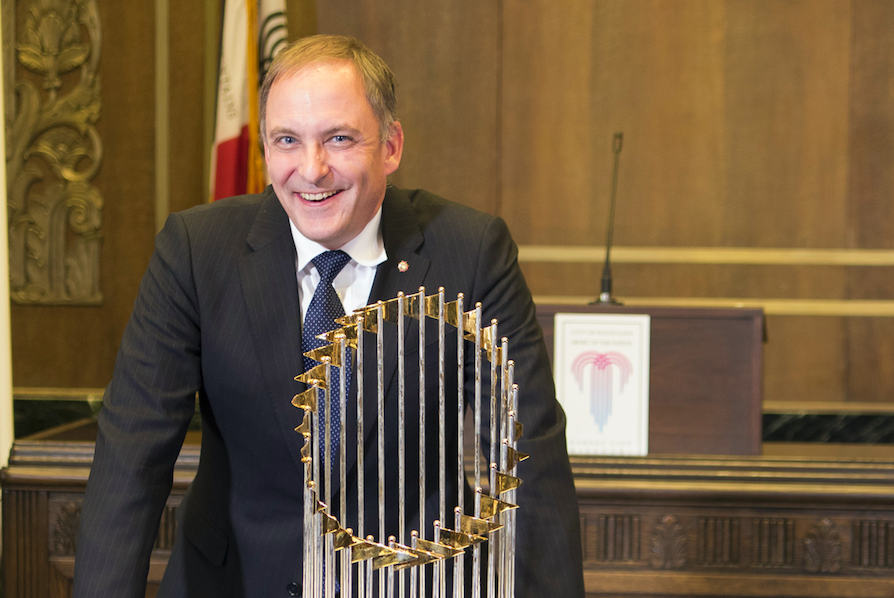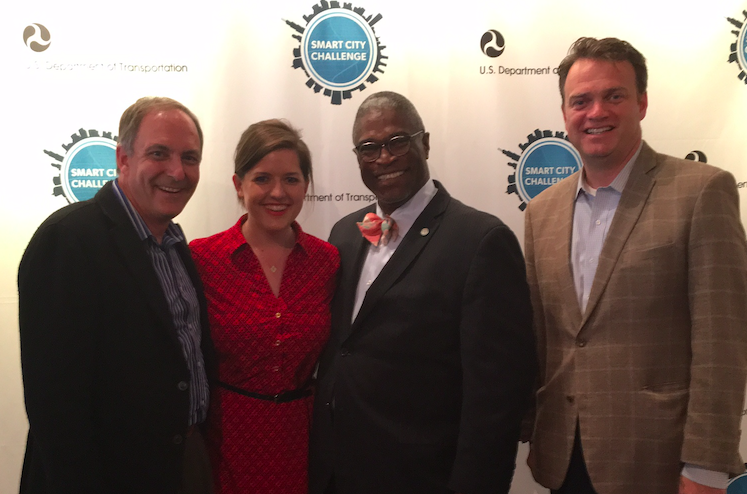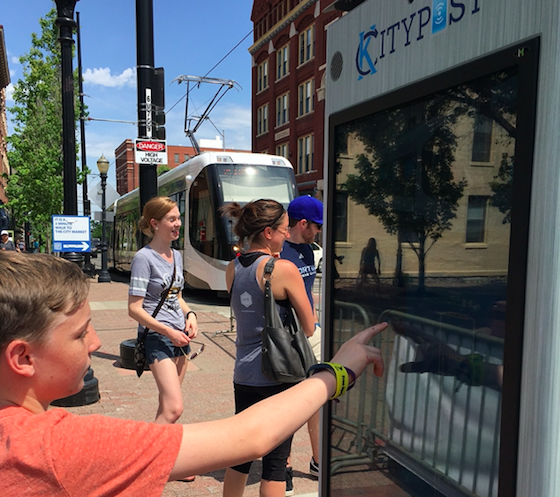
Photo: Screen-Shot-2018-06-11-at-12.03.24
The CIO leading Kansas City’s innovations
06 June 2018
by Jonathan Andrews
Jonathan Andrews spoke to Bob Bennett, Chief Innovation Officer in Kansas City, Missouri as he prepares to move to phase two of the smart city strategy and expand the five-square kilometre test-bed to the entire city
When looking at the career background of most city CIOs, you would likely expect to read about experience in the technology and IT sectors, or public administration. Rather less expected would be a 24-years stint in the US Army, but Bob Bennett is an exception: he was still on active service when he applied for the role of CIO for Kansas City.
A graduate of the prestigious United States Military Academy at West Point, Bennett served in the US Army in Germany, Italy and Iraq. Towards the end of his service in 2015, he took up a strategic-level consulting job for a local non-profit, one of whose members happened to be a former mayor of Kansas City, who informed Bennett about what the city was planning.
“Some of the things that we talked about in that strategic planning session nestled very nicely with how Mayor James and City Manager Schulte were looking at the future of Kansas City as a connected community,” he says. “I thought that was interesting.”
What caught Bennett’s attention was not only the mayor’s need to build a 21st-century connected city, but also the plan to first implement this idea in a five-square-kilometre sector of the downtown area instead of an immediate launch across the entire city.
Bennett was appointed as CIO in January 2016, and began to engage in the US Department of Transportation’s Smart City Challenge which took place that year. Although missing out on the US$50 million first prize, the city was one of seven finalists and was able to gather enough funding to start its data analysis programme, putting into action a smart city strategy that cuts across city government and includes non-profit organisations and many commercial entities.

Here, Bennett was able to plug into his army experience of “getting things done, no matter what”.
“The mission that we were assigned was to build up a smart city framework in Kansas City. It had to be accomplished, period. It was just non-negotiable,” he says. “Over the course of the last couple of years, certainly the conditions have changed and it has not always been ideal, but the singular focus upon that mission has not changed. This has allowed us to generate alternatives when what looked like the initial solution simply didn’t pan out.”
Kansas City’s ‘Smart City Phase 1’ became operational in May 2016 at the same time as the opening of the city’s streetcar, or light rail, line. Along this five-kilometre streetcar corridor, digital infrastructure was installed including 328 Wi-Fi transmitters, 26 K City Posts kiosks as information points for residents and visitors, and178 streetlights that enhance traffic movement and adjust lights to meet citizen needs through artificial intelligence.
“Our smart city initiative is unique because we installed all of our infrastructure in depth along one corridor to best understand what is possible,” Bennett explains.
He likens the smart city movement to the first industrial revolution, saying that then, as now, it was necessary to start small as no-one had the ability or knowledge to work at scale.
“You have to start the experiments at a smaller scale and then you get to a point at which lessons learned can be shared, because they are actually truly lessons learned and not gut feelings, and you’ve got sufficient development to understand what the control looks like and not just the experiment,” he says.
Bennett is the first to admit that some initiatives have not been successful. Nonetheless, he says that working in a small area allowed the city to be more experimental and not be afraid to fail.
“One transit solution, Bridj, failed, so we changed the model and now have a much more effective platform called KCFreedom that serves our disabled population and provides large-scale, responsive transportation for all our users,” he explains.
The city has also been able to adjust how it collects traffic and pedestrian count data and has begun to explore reusing existing sensors alongside a cheaper, remotely-accessible software solution. “By combining all these capabilities in one place, we understand holistically how a smart city can work,” says Bennett.
Vendor partnerships
Phase one has also helped Bennett in his understanding of vendor needs, as the downtown area has been able to validate a specific technology or concept that vendors can then “use to make money elsewhere”.
At the national level, he is a Co-Chair on the Global City Team Challenge–300 members of which are city officials. This collaboration, led by the National Institute of Standards and Technology, is working to build a framework to ensure cities become a fertile ground for smart city commercial ventures.
“We all believe that there are common things that we can measure and to the extent that we can agree on what those are, it allows us to go back to our vendors and industry partners to come up with at least a common framework of what needs to be measured.”
Bennett says this then drives down the price of the infrastructure, making it more affordable for cities.

Importance of data over infrastructure
Bennett and his team realised from phase one that beginning with data was more important than infrastructure.
“Quite frankly, we already had about 85 percent of the data we needed to be a smart city. What we actually needed was a better analytics platform, and a better definition of how we assess our performance.”
Here, he was able to draw on his army experience. In the last seven years of his service, he was a strategic planner for Generals Petraeus and Odierno and focused on how to build an inter-agency strategy towards the end of the Iraq war.
Bennett’s task was to coordinate disparate groups like the Department of Defense, Department of State, the US Agency for International Development, the nascent government of Iraq at the time, and the international coalition to agree on a single policy.
“It was difficult but it allowed us to figure out a way to maximise shared objectives,” he says. “That same methodology works in city government. You have 19 very independent city departments here in Kansas City, each of which are incredibly well suited to their tasks and incredibly good at them but they don’t always necessarily overlap. I was able to help clarify for [the department heads] where these shared spaces were and it helped us build a much more comprehensive strategy.”
Bennett says that this also made governance smarter. He believes that technology, in itself, is not smart and that while sensors that are connected to decision-making may make headlines, they don’t help a city make progress in solving its problems.
“When these governance and policy decisions are made, the city can focus on collecting the relevant data, much of which already exists in city offices,” he adds. “Only then should sensors be deployed to collect the specific data required to better understand the community.”
He says that for a city to be truly smart, it must understand its citizens’ needs, develop a comprehensive plan where all departments collaborate to solve issues, and have policies that govern what role data collection, use, privacy settings and sharing will play.
Phase two
Bennett is now planning phase two, an ambitious expansion to transfer, scale and replicate what the city has been doing in these five square kilometres to cover the entire 824-square kilometre city area. This will begin with the eastern third of the city, where many of the same capabilities from the first phase will be implemented along the new bus rapid transit route, called Prospect MAX.

Other key points of phase two will be expanding the streetcar line and coordinating with the city’s water department to deploy smart sewers, advanced metering infrastructure and other improved technologies as part of a scheduled life-cycle replacement of existing equipment.
The city is tendering for 10- to 30-year partnerships with vendors to help implement phase two. “By moving into phase two, we have to look at how [vendors] can generate a profitable bottom line,” he explains. “What are the aspects that the city can provide to be an equal partner in these agreements and how can we identify and clearly represent the public good in these negotiations while still allowing a framework to exist? This allows those corporate partners to profit voluntarily from the operations.”
One partnership pilot that Kansas City has is with car rental company, Avis. The company’s Kansas City 5,000-strong fleet is connected to the Internet, other vehicles, and to the car rental company via wireless technology that is not only assisting the company’s fleet-management services but is also helping the city to analyse data during certain peak traffic periods.
On 7 March, the same day a basketball tournament was being held in the city, Avis sent out 10 teams of four people participating in what was essentially a digital scavenger hunt.
“We are going to be able to figure out if we were able to provide those users with effective traffic guidance so they can minimise the time they are on the road and maximise the time they are at museums or at restaurants,” explains Bennett.
The city is analysing what the city team have learnt from that first connected-car demonstration.
“Avis as a private vendor–certainly through contractual obligations–knows a great deal about its customers,” he explains. “I, as a city, do not and so I get to validate that data. It’s very anonymous, very ‘vanilla’ data that does the things I need it to do for the city in terms of better representing my traffic flow, better representing my parking requirements and those things.”
With four major US city CIOs having left office at the end of 2017–most of whom were mayoral appointees–Bennett is not concerned that the transient nature of the job will have an impact on future smart city strategies or indeed his own legacy. With Kansas City, he is positive that the next city administration will remain on the same path that he started upon two years ago, and will see through the completion of phase two.
“I myself am probably [a year] from having to transition because I am also a mayoral appointee, but I know of the individuals running to succeed my mayor,” he says. “All of them are data-driven and every single one of them is going to need to have the ability to look at how the city is performing, to understand the interrelationships among our 19 departments and to digitise the wisdom of those 19 departments to help them make better decisions.”








